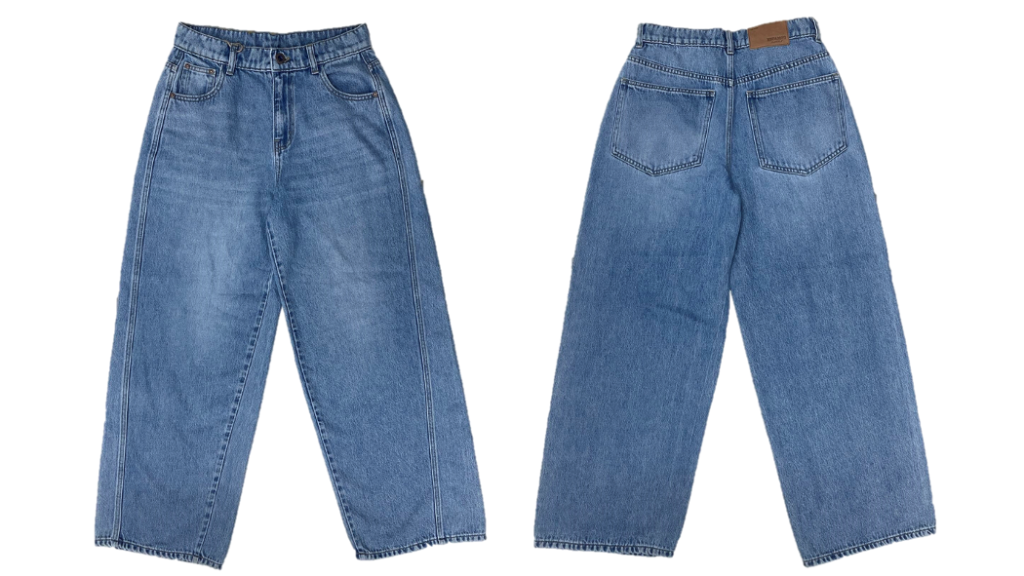
XDD Denim Ushers in a ‘Cotton Revolution’ with TENCEL™ Fibers

Vietnam-based XDD Denim is proving jeans can be made from more than cotton.
As part of its raw material diversification, the mill is using TENCEL™ fiber innovations to make denim that is comfortable, soft, colorfast and sustainable. TENCEL™ is also versatile, allowing XDD to achieve both drapey or structured silhouettes.
Here, Wilson Li, marketing director of XDD, discusses its latest TENCEL™ creations, how it is making zero cotton and zero virgin cotton denim, and striking a balance between practicality and sustainability.
Carved in Blue: What was the concept behind these fabrics you created with TENCEL™ fibers?
Wilson: The concept behind this denim development is centered around the “Cotton Revolution.” Our primary goal is to replace a significant portion of cotton in denim with environmentally friendly fibers while maintaining the classic aesthetic of denim and incorporating advanced comfort. In this project, we have utilized a substantial amount of TENCEL™ fibers to achieve the idea of “zero cotton” or “zero virgin cotton.”
We chose TENCEL™ fibers because they are derived from natural wood pulp and are well-known for their exceptional sustainability and environmental benefits. The production process of TENCEL™ fibers employs recycled solvents and is highly efficient in water usage. Compared to traditional cotton, TENCEL™ fiber production requires significantly less water, thereby reducing the need for agricultural land and pesticides. This innovative approach not only enhances the comfort and style of denim but also aligns with our commitment to sustainability.
Carved in Blue: How long have you been using TENCEL™ Modal with Indigo Color technology? What types of fabrics are you choosing the dope dyed fibers for?
Wilson: We have been using TENCEL™ Modal with Indigo Color technology for the third season now, and we truly value its benefits. One of the key reasons we love this technology is its remarkable color retention, which provides our denim with a luxurious indigo hue and feel. Additionally, TENCEL™ Modal is designed with sustainability in mind, especially due to its biodegradable properties.
Among the various types of denim, selvedge is considered one of the most classic weaves. Therefore, we chose to integrate TENCEL™ Modal with Indigo Color technology into this timeless weaving method. Our goal is to create a piece of denim that not only showcases a premium indigo shade and texture but also embodies a strong commitment to environmental sustainability.
Moreover, we have blended recycled cotton and hemp fibers into our shirt fabric. This combination maintains the unique rugged appearance of hemp while using TENCEL™ Modal with Indigo Color technology to enhance its original texture, resulting in a softer and more comfortable feel.
To meet the diverse needs of our customers, we have also incorporated TENCEL™ Modal with Indigo Color technology into various fabrics commonly used by our clientele, adding a touch of sophistication and sustainability to our collection.
Carved in Blue: How do you choose between TENCEL™ Lyocell and Modal for denim fabrics? What attributes of each fiber type do you lean toward for different styles?
Wilson: Choosing between TENCEL™ Lyocell and TENCEL™ Modal for denim fabrics involves considering the specific attributes of each fiber type and how they align with the desired style, performance and sustainability goals of the garment.
TENCEL™ Lyocell fibers are known for their high strength, making them durable and resistant to wear and tear. This is particularly beneficial for denim that requires longevity. In addition, it has excellent moisture-wicking properties, allowing it to absorb moisture effectively while remaining breathable. This can enhance comfort in various climates. While both fibers are soft, lyocell tends to be slightly softer and smoother, which can contribute to a luxurious hand feel.
If the denim style is more structured, such as in traditional jeans or jackets, TENCEL™ Lyocell may be the better option due to its durability and strength.
TENCEL™ Modal is exceptionally soft and drapes beautifully, giving it a more fluid and relaxed feel, which is perfect for casual styles.
Known for its comfort, modal is great for garments that prioritize softness and a gentle touch against the skin. It is perfect for more relaxed denim styles, such as soft joggers or loose-fitting jeans, where comfort and drape are key. If the design calls for a more fashion-oriented look with a softer silhouette, TENCEL™ Modal’s attributes can enhance the overall aesthetic.
Ultimately, the choice between TENCEL™ Lyocell and Modal will depend on the specific attributes we want to highlight in our denim fabrics and the overall vision for our collection. Both fibers offer excellent sustainability credentials, we feel good about either choice from an environmental perspective.
Carved in Blue: Could you detail the material compositions of these textiles? What blending partners were used, and in what proportions?
Wilson: As our collection centers around the concept of the “Cotton Revolution,” two of its key features are Zero Cotton and Zero Virgin Cotton. With this in mind, we have made a concerted effort to minimize or eliminate the use of traditional cotton in our fabric compositions. Instead, we have incorporated a substantial amount of cellulosic fibers to replace cotton, including recycled cotton, TENCEL™ Lyocell, TENCEL™ Modal, hemp and linen.
For instance, one of our denim fabrics is made of 100 percent TENCEL™ Lyocell, while another features a blend of recycled cotton, TENCEL™ Lyocell and TENCEL™ Modal to further reduce the usage of new cotton.
However, we face a practical challenge regarding tariffs. Since the primary components of these denim fabrics are not cotton, they incur higher tariffs. To address this issue and meet our customers’ needs, we have strategically incorporated the maximum possible amount of recycled cotton and sustainably grown new cotton, such as BCI Cotton or regenerative cotton, ensuring that cotton remains the main component. This approach allows us to maintain fabric quality while balancing our commitment to sustainability with the realities of the market.
By thoughtfully blending these fibers, we aim to achieve a balance between extreme environmental responsibility and practical considerations.
Carved in Blue: How did XDD Denim work with the Lenzing denim team on the creation of these textiles?
Wilson: The collaboration between XDD team and Lenzing denim team has led to a series of innovative and diverse development concepts, thanks to our numerous meetings and discussions. The Lenzing Denim team provides extensive support to the XDD team by offering expert material selection advice tailored to our various denim applications. They assist in performance evaluations to ensure that the chosen fibers meet essential criteria for strength, softness, moisture management and breathability. Additionally, throughout the production process, XDD team benefits from Lenzing’s technical support, guiding us on how to optimize fiber processing and textile technologies to enhance production efficiency and product quality. Together, we analyze market trends and consumer demands, formulating a comprehensive product strategy. Once the products are launched, we also collaborate on effective marketing strategies to ensure a win-win situation for both our existing clients and those of Lenzing.
Carved in Blue: What washes and wash effects did you develop or test with these fabrics?
Wilson: In our collaboration with the Lenzing team on this exquisite collection, we intentionally chose not to employ overly aggressive washing styles. The denim fabric, crafted from TENCEL™ Lyocell and Modal, already embodies the perfect blend of style, color and texture that meets our aesthetic desires. We wanted to preserve the inherent beauty of the fabric rather than obscure its natural hues and luxurious hand feel with harsh treatments. Instead, we opted for a subtle wash, hand-sanding and gentle distressing, which elegantly enhance the denim’s original charm. For certain garments, we aimed to evoke a vintage allure, so we delicately applied a hint of tinting to achieve that timeless effect.
Overall, the TENCEL™ Lyocell and Modal denim proves to be remarkably easy to work with, allowing us to achieve our desired results effortlessly while maintaining its striking beauty.
Carved in Blue: What types of garments would the fabrics be a good fit for? How can product developers incorporate them into collections?
Wilson: The use of TENCEL™ Lyocell and Modal fabrics in garments offers a range of possibilities due to their unique properties, making them suitable for various types of garments. Here are some suggestions.
In tops, the softness and breathability of TENCEL™ fabrics make them ideal for comfortable everyday wear. They can be used for stylish blouses.
For loungewear, the luxurious feel of TENCEL™ Lyocell and Modal is perfect for creating cozy loungewear sets, such as joggers.
Combining TENCEL™ Lyocell or Modal with traditional denim offers enhanced softness and drape, making for comfortable yet stylish jeans.
The lightweight and breathable qualities of these fabrics lend themselves well to stylish denim jackets that are perfect for layering.
For flowy dresses, TENCEL™ fabrics drape beautifully, making them excellent for maxi dresses, sundresses or wrap dresses that require a soft, flowing silhouette.
A-line skirts can benefit from the natural drape and movement of TENCEL™, providing a flattering fit and comfort.
By thoughtfully integrating TENCEL™ Lyocell and Modal fabrics into collections, product developers can create stylish, comfortable and sustainable garments that resonate with modern consumers.










